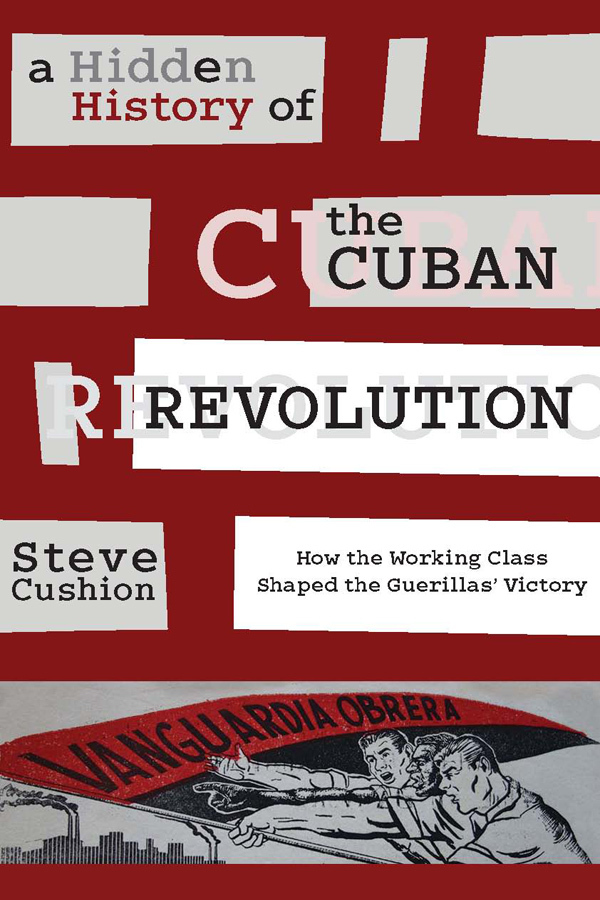
A Hidden History of the Cuban Revolution: How the Working Class Shaped the Guerrillas’ Victory
Steve Cushion
Monthly Review Press, 2016, 272pp, £18.99
This important work highlights the essential role played by the Cuban working class in the insurrectionary war against the Batista dictatorship in 1950s Cuba. From shop stewards and trade union officials to clandestine networks of militants organised into revolutionary workers’ sections by the Movement of the 26th July (M-26-7), Cushion demonstrates that without the contribution of working-class forms of struggle the Cuban Revolution would not have succeeded. He shows how workers organised despite threats of unemployment and violent repression through solidarity strikes in industries including sugar, textiles, transport, banking and electricity. Sugar workers burned fields; telephone workers cut wires as they walked out on strike; and telephone operators listened in on police conversations to support the armed struggle.
In 1955, a sugar workers’ strike mobilised half a million, supported by student activists. Their strike was accompanied by formidable bank and railway strikes. A series of civic strikes shut down Camaguey, Guantanamo, Moron, Nuevitas and Santiago, turning them into ghost towns. The state responded with armed police, soldiers and secret police to force people back to work. Aligned to Batista, the Confederation of Cuban Workers (CTC) accepted an 8% wage reduction and 600 layoffs, and signed a no-strike agreement.
Increasingly workers combined industrial action with sabotage. Railway workers in Guantanamo developed ‘war trade unionism’, combining strikes with bombings and de-railings. The M-26-7 set up an explosives workshop among Cuban workers in the US Naval Base in occupied Guantanamo.
Cushion provides an overview of the crisis of productivity in Cuba’s sugar industry, competing ideologies of economic nationalism and the relationships of Cuban students and women to working-class struggles. Prior to Batista’s coup, Cuban capitalism was unable to maintain wages previously agreed with labour unions and profits. He examines the three organisations through which the Cuban working class mobilised in the 1950s: the Cuban Communist Party (CCP), the CTC and M-26-7.
The (old) CCP
Founded in 1925 with assistance from the USSR’s Communist International, the CCP oscillated between militancy and opportunism. During the rise of fascism in Europe, the pro-Soviet CCP adopted the ‘popular front’ policy of cross-class alliances. Consequently, in 1940, the CCP supported Batista’s successful candidacy for President, gaining two cabinet seats. This enabled them to introduce minor labour reforms, but in 1943 the then CCP-controlled CTC signed a no-strike truce for the duration of the war. In 1944 the CCP was renamed the Popular Socialist Party (PSP).
Despite their previous alliance, the PSP was the first party to publicly condemn Batista’s 1952 coup. They called for a ‘national democratic front’ to oppose Batista through legal means. The anti-communism of the other parties made this impossible.
Immediate resistance to the coup from organised labour was mainly limited to strikes on the Havana bus routes and in the Matanzas textile industry. During the employers’ offensive of 1955-6 the government and business attacked the working class sector by sector. Wages were cut, workers were sacked, the working day extended, and industries mechanised, to raise productivity and profitability. The PSP then found their main support among dockworkers, tobacco workers and hotel and catering workers, where their tactic of widespread workplace-based strike action still achieved results.
Following the Revolutionary Directorate’s (DR – student organisation) bloody attack on the Presidential Palace on 13 March 1957, communists were prohibited from public service and the PSP increasingly went underground. In 1958, they joined M-26-7 in founding the National Workers Front, independent from the corrupt CTC.
In 1961, the PSP merged with M-26-7 and the DR into the Integrated Revolutionary Organisations (ORI), leading to the creation of a new Cuban Communist Party in 1965, which leads Cuba to this day.
The CTC
The CTC was founded in 1939 to organise the Cuban labour movement into a single federation. With over one million members, from a total population of six million, this represented the highest proportion of unionised workers in Latin America. In 1947, the governing Autentico Party handed leadership of the CTC to Eusebio Mujal and a murderous purge of communists and other radicals began. Mujal fixed trade union elections and used corrupt means and state violence to supplement his salary of $280,000. He pledged allegiance to Batista and turned to the brutal state apparatus to control the working class.
M-26-7
The movement built by Fidel Castro and others to oppose dictatorship came to national prominence with the attack on Moncada Barracks on 26 July 1953. Although the attack was initially condemned as ‘putschist’ by the PSP, Cushion describes the developing relationship between M-26-7 and PSP, and points to similarities in their political programmes. He explains how M-26-7 set up workers’ sections, and how such groups in Guantanamo and Santiago used industrial action and sabotage to support the arrival from Mexico of the nascent Rebel Army in late 1956. In Santiago, the PSP militants defied a direct order from the PSP Central Committee not to get involved. In March 1958, the PSP publicly announced support for the Rebel Army.
Cushion details the large general strikes of 1957 (successful) and 1958 (unsuccessful) organised by M-26-7 and how, with increasing PSP collaboration, they were able to call a complete general strike in early January 1959 which paralysed Cuba and ensured the revolution’s success.
A must-read
Cushion draws from many clandestine publications, archives and interviews with veterans of Cuban working-class struggles. He introduces inspiring characters, from Juan Taquechel, leader of the Santiago dockers, and sugar trade unionist Conrado Becquer, to legendary revolutionaries such as M-26-7 organiser Frank Pais. Following Pais’ assassination in 1957, his funeral was attended by 60,000 workers and provoked a general strike. Cushion also explores different forms of organisation, actions and events – detailing the essential role of workers in the Cuban Revolution. This book is strongly recommended.
Andrew George
Fight Racism! Fight Imperialism! 252 August/September 2016




